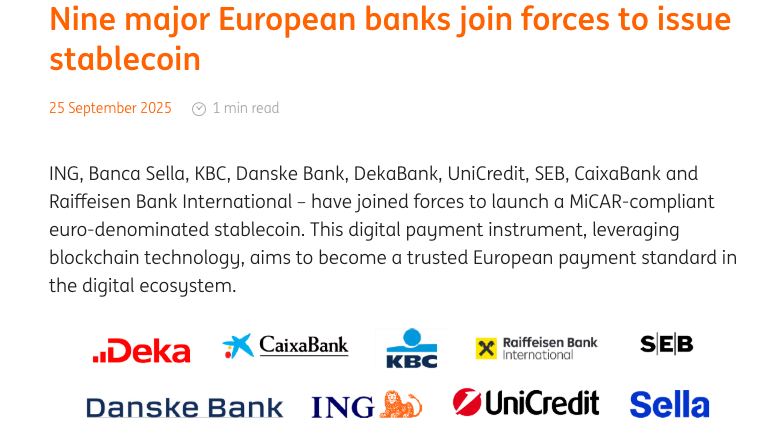ING, UniCredit Join Nine-Bank Push for MiCA-Compliant Euro Stablecoin Launching in 2026
A coalition of nine major European banks, including ING and UniCredit, is developing a MiCA-compliant euro-pegged stablecoin set to launch in the second half of 2026. The project aims to provide a European alternative to U.S.-dominated stablecoins and strengthen the EU’s digital payment autonomy.
- Fully compliant with Europe’s Markets in Crypto-Assets regulation, ensuring regulatory clarity and consumer protection.
- Euro-denominated stablecoin planned for H2 2026; managed by a new Netherlands-based company.
- 24/7 cross-border payments, near-instant low-cost settlements, programmable payments, and streamlined supply-chain and digital-asset settlement.
- Provide a European payment standard to reduce reliance on U.S. stablecoins and support EU financial sovereignty.
- Follows delays of the digital euro CBDC to 2029, prompting speculation the stablecoin could serve as a “backdoor CBDC.”
A powerful group of European banks is teaming up to launch a MiCA-compliant euro stablecoin designed to reshape Europe’s digital payment landscape. Dutch lender ING and Italy’s UniCredit revealed Thursday that they are part of a nine-bank consortium creating a euro-pegged stablecoin scheduled to debut in the second half of 2026.
The initiative seeks to establish a trusted European payment standard, offering a homegrown alternative to U.S.-backed stablecoins like USDC and USDT. According to the joint statement, the stablecoin will provide near-instant, low-cost transactions, enabling 24/7 cross-border payments and programmable settlement capabilities that could enhance supply-chain management and digital-asset markets.
Alongside ING and UniCredit, founding members include Spain’s CaixaBank, Denmark’s Danske Bank, Austria’s Raiffeisen Bank International, Belgium’s KBC, Sweden’s SEB, Germany’s DekaBank, and Italy’s Banca Sella. A newly formed company headquartered in the Netherlands will oversee the stablecoin’s development and operations, and the group has signaled it is open to additional bank participants.

The project is notable for its alignment with the EU’s Markets in Crypto-Assets (MiCA) regulation, which provides clear rules for digital-asset issuance and trading. By adhering to MiCA, the consortium aims to ensure strong regulatory compliance and consumer protections—key factors as Europe seeks greater strategic autonomy in payments.
This announcement arrives as the European Central Bank’s digital euro faces delays. ECB Executive Board member Piero Cipollone recently projected a digital euro launch no earlier than 2029, with the European Parliament expected to outline a framework by May 2026. The lag has fueled debate, with some observers dubbing the new stablecoin a “digital euro’s obituary notice” or even a “backdoor CBDC,” though stablecoins are issued by private entities rather than central banks.
Global policy shifts add further context: in early 2025, the U.S. banned central bank digital currency development while promoting dollar-backed stablecoins, signaling a growing preference for private-sector solutions. Europe’s new initiative reflects a similar pivot—leveraging private bank innovation to create a MiCA-regulated stablecoin that could fill the digital euro gap and compete with U.S. stablecoin dominance.
Final Thought
With heavyweights like ING and UniCredit on board, this MiCA-compliant euro stablecoin could redefine European digital payments by 2026, positioning the EU as a serious contender in the global stablecoin race.



